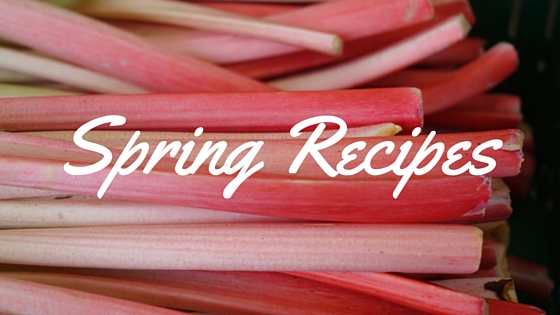Spring Recipes
Now that Spring has sprung, the signs of summer are here. Warmer weather, a little more sunshine. It also means that Farmer’s Markets are starting to open up for the season and some spring veggies are in season.
This is a great time for asparagus, Swiss chard, fennel, fava beans, and rhubarb are all in season. So, what do you do with this surplus of goodness? We share a couple of our favorite recipes here.
What exactly is rhubarb? Rhubarb is a vegetable that grows from the ground. It’s typically sold in stalks, similar to celery with the exception of rhubarb’s beautiful reddish color. Most people are very familiar with Rhubarb Pie. Believe it or not, rhubarb can make a delicious jam. If you love preserves, here’s a fantastic recipe from Jane Ward :
Rhubarb and Ginger Jam
(makes six 8-ounce jars)
What You Need:
3 pounds of trimmed rhubarb stalks, cut into 1/2-inch pieces
3 cups granulated sugar
1/4 cup crystallized ginger, finely chopped
1/4 cup grated fresh ginger
Directions:
Combine the rhubarb, two types of ginger, and sugar in a large saucepan. Stir over medium-high heat until the sugar dissolves and the mixture begins to bubble. Once boiling, reduce the heat to medium and simmer, stirring frequently, until jam thickens. Adjust heat accordingly to maintain a steady simmer and stir often during the thickening process to prevent scorching. Cook for about 20 to 25 minutes, skimming and discarding the foam that collects on the top of the mixture.
After 20 minutes, test for doneness. Turn off the heat under the jam and take the temperature of the fruit mixture using a candy/jelly thermometer. The thermometer should read about 220 degrees when the jam is done. Alternately, place a small spoonful of jam on a plate and place the plate in the freezer for 35-45 seconds. Remove the plate and run your finger over the top of the jam. The surface should “wrinkle” in your finger’s wake. If it does, the jam is done.
Ladle the mixture into hot, sterilized 8-ounce jam jars leaving about 1/4-inch of space between the jam and rim of the jar. Cover with lids and rings and process the jars for 10 minutes in a hot water bath. The lids should vacuum seal shortly after removing the jars from the processing bath. If you do not hear the telltale “pop” of some or any of the lids, return the unfinished jars to the boiling water and process for an additional five minutes.
Place the sealed jars on the thickness of a kitchen towel and allow to rest and cool completely overnight. Preserves will keep for at least a year in the sealed jars if kept in a moderate temperature.
Swiss Chard is another one of those vegetables that no one seems to know about or can be underutilized in the kitchen. Yes, you can steam chard or sauté with a little olive oil and garlic. What other creative uses are out there for Swiss Chard? Tons!
This one was pretty appealing and hearty from Martha Stewart Living. And the great thing is that it’s surprisingly simple.
Creamed Swiss Chard
What you need:
2 tablespoons water
4 bunches Swiss chard, stems removed, leaves cut into 1-inch strips
1/4 cup (1/2 stick) unsalted butter
1/4 cup all-purpose flour
1 1/2 cups whole milk
1/4 teaspoon ground nutmeg
Coarse salt and ground pepper
Directions:
In a large pot, bring water to a boil over medium-high. Gradually add chard and cook until it is just wilted, 2 to 3 minutes. Transfer to a colander to drain, pressing out as much liquid as possible.
In pot, melt butter. Whisking constantly, add flour and cook 1 minute. Whisking constantly, slowly add milk. Cook, whisking along bottom of pot, until mixture comes to a boil and thickens, 2 to 3 minutes. Add chard and stir until coated. Stir in nutmeg and season with salt and pepper.
How simple is that?
What are your favorite recipes with spring vegetables? We’d love to hear them.


 Facebook
Facebook Twitter
Twitter